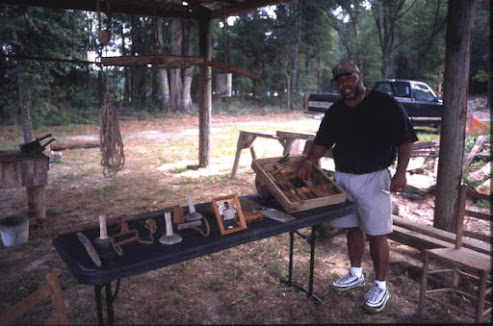Summer Callahan, sc11
Tuesday, November 23, 2021
Renaissance Park Cultural Festival
Leon Kelley shows his grandfather’s butchering tools at the Renaissance Park Living Heritage Festival (2000). The festival was a joint project between Danny Silvester, founder, and Martha Ellen Davis, ethnomusicologist, which showcased and celebrated African-American folklife in Marianna, Florida. Though the Florida Folklife Program was still housed within the Division of Historical Resources, the festival was funded through a Division of Cultural Affairs grant.
Theory and Craft of Preservation Advocacy
This book is titled The Theory and Craft of Digital Preservation, but it seems to me that this text is really preoccupied with advocacy. Half of the sixteen axioms are about shaping the conversation around digital preservation—there’s an assumption built-in that the reader or the reader’s audience must be disabused of notions that preservation has “already happened” or that digital preservation is as simple as backing up files before any real work can commence. The talking points are useful to public historians as-in (who in many cases are making the preservationist decisions) and should serve as a starting place to make their own talking points to frame their specific fields of study to the un-initiated—since public historians are likely to be working at cultural or educational sites and therefore need to justify their work and their expenses to directors (whose interests and knowledge of the subject can vary wildly), legislators, funders and ideally volunteers who can assist with some low-level preservation work. (The caution against one-and-done software purchases or any other new and fancy tool is going to be very useful for any digital preservationist looking to defend their job when the next bout of funding cuts inevitably rolls through.)
The way that Owens describes his approach
to digital preservation seems to approach a proto-memex as described by
Vennevar Bush—digital content where original order is not necessary, as all
information is linked together vertically and horizontally. Of course, all my
original complaints about the memex still stand, and this is still digital
preservation that’s clustered around any given cultural institution, serving
that institution’s priorities, and which only a sliver is being cultivated and
maintained rather than the bulk.
Saturday, February 6, 2021
My Big Idea Might Be a Bad Idea (Professionally)
I think the Big Idea of my digital history project will be the changing relationship of the State to “folklife.” What constitutes Folklife versus merely folk practices, e.g., when does the state feel obligated to document or protect some form of folk practice? What is emphasized as folklife and what is not? How does “folklife” (a huge and complicated term in this context in its own right) benefit or not benefit from bureaucratic oversight? What is the implication of “folklife” housed with Division of Historical Resources and what does it mean that it's being moved over to Division of Cultural Affairs? I know that the "real" answer here is that the National Endowment for the Arts, who also funds Cultural Affairs, only wants to manage one grant--so how can I separate out the "real" (mundane, mostly technical answers) from larger trends?
This is further complicated because I do work for this department and I anticipate using some of this research in a work setting. Of course, no historian is truly a free agent, since historians are usually beholden to institutions, but it seems as though public historians experience this obligation tenfold. If my research were to show that some folk practices in Florida (among Black or Native American populations, for example) were not highly regarded by the state government until they were effectively endangered or relegated to the realm of the past--how would I present that? Or if part of the research is that "folklife" in practice means groups living in poverty, what's the implication that those impoverished groups are also Black or Native American? I haven't started deeply researching this but I suspect that at the end of this project, there will be a possible conversation about the ways that the state and federal government has negatively impacted the Florida's participants in folklife, then pivoted and curated a form of nonthreatening Folklife. That's not something that I think I can realistically present in a work setting, though of course that makes me in some way complicit. And it's a further complication in that good projects require Big Ideas, so if the product of my research is what I suspect it will be, I will need to be able to create a revised second project with its own Big Idea.
